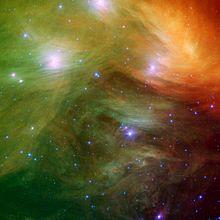| Reflection nebula | |
|---|---|
 The Merope Nebula and surrounding nebulosity in Pleiades, taken by the Spitzer space telescope | |
| Observation data: J2000 epoch | |
| Right ascension | 03h 46m [1] |
| Declination | +23° 54′[1] |
| Distance | 440[2] ly (130 pc) |
| Apparent magnitude (V) | 13 (IC 349)[2] |
| Apparent dimensions (V) | 30′[2] |
| Constellation | Taurus |
| Physical characteristics | |
| Radius | 2 ly |
| Absolute magnitude (V) | 8 |
| Notable features | In Pleiades; contains IC 349 |
| Designations | NGC 1435, Merope Nebula, Tempel's Nebula[2] |
The Merope Nebula (also known as Tempel's Nebula and NGC 1435) is a diffuse reflection nebula in the Pleiades star cluster, surrounding the 4th magnitude star Merope. It was discovered on October 19, 1859 by the German astronomer Wilhelm Tempel. The discovery was made using a 10.5cm refractor.[3] John Herschel included it as 768 in his General Catalogue of Nebulae and Clusters of Stars but never observed it himself.[4]
The Merope Nebula has an apparent magnitude starting at 13[2] and quickly dimming by a factor of about 15,[5] making most of the nebula dimmer than magnitude 16. It is illuminated entirely by the star Merope, which is embedded in the nebula. It contains a bright knot, IC 349,[2] about half an arcminute wide near Merope, which was discovered by Edward Emerson Barnard in November 1890. It is naturally very bright but is almost hidden in the radiance of Merope.[6] It appears blue in photographs because of the fine carbon dust spread throughout the cloud. Though it was once thought the Pleiades formed from this and surrounding nebulae, it is now known that the Pleiades nebulosity is caused by a chance encounter with the cloud.
Gallery
References
- ^ a b "NGC 1435". SIMBAD. Centre de données astronomiques de Strasbourg. Retrieved 2011-07-04.
- ^ a b c d e f "SEDS Students for the Exploration and Development of Space". The star Merope and its Nebula NGC 1435/IC 349 in the Pleiades. Retrieved 2007-08-22.
- ^ Steinicke, Wolfgang (2010). Observing and Cataloguing Nebulae and Star Clusters: From Herschel to Dreyer's New General Catalogue. Cambridge University Press. p. 523. ISBN 9781316644188.
- ^ Steinicke, Wolfgang (2010). Observing and Cataloguing Nebulae and Star Clusters: From Herschel to Dreyer's New General Catalogue. Cambridge University Press. p. 528. ISBN 9781316644188.
- ^ Herbig, G. H. (1996). "IC 349: Barnard's Merope Nebula". Astronomical Journal. 111: 1241. Bibcode:1996AJ....111.1241H. doi:10.1086/117869.
- ^ Merope, Star-Names and their meanings, Richard Hinckley Allen, Dover Publications, 1963,pg. 406.
External links
 Media related to NGC 1435 at Wikimedia Commons
Media related to NGC 1435 at Wikimedia Commons- NASA Astronomy Picture of the Day: Reflection Nebula NGC 1435 (1 March 1999)
- Seds NGC 1435 page

